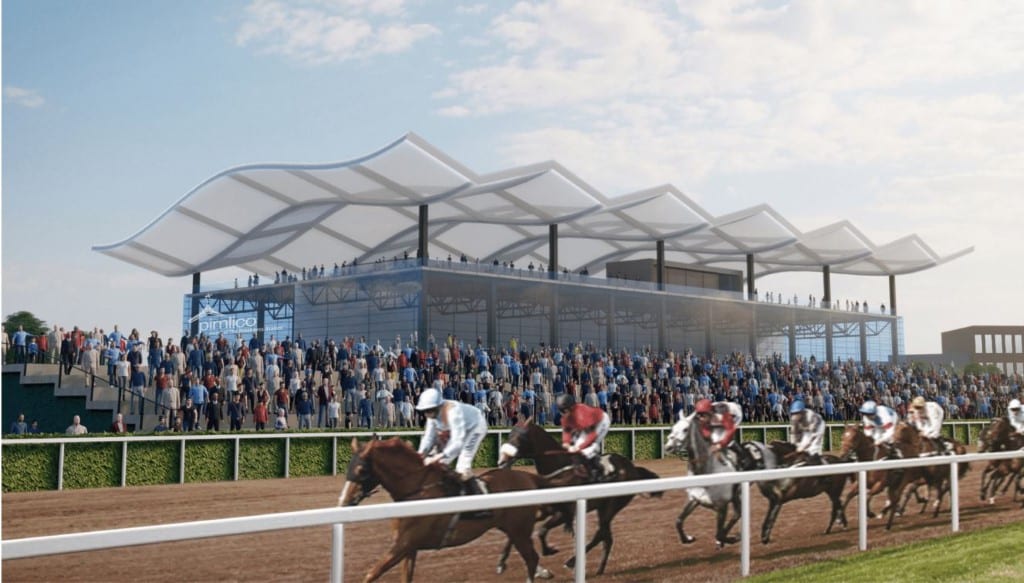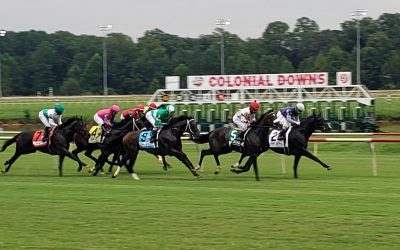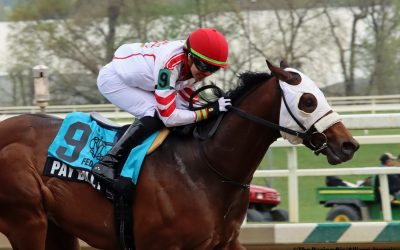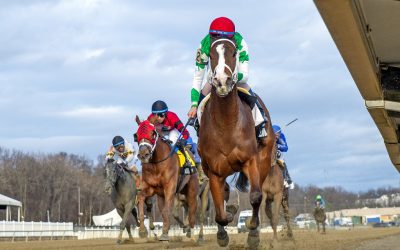Industry insiders laud Pimlico plan: “Our Triple Crown”

An artist’s rendering of the Pimlico concept plan prepared by the design firm Populous.
Don’t look for Plan B, because there isn’t one.
That was one takeaway from the Maryland Thoroughbred Horsemen’s Association’s Q-and-A session on the future of Pimlico, which attracted several dozen horsemen and others to Laurel Park Tuesday afternoon.
“Look at the option if this plan doesn’t happen; look at the option if we can’t guarantee the Preakness at Pimlico,” said MTHA general counsel Alan Foreman after the session. “What is the option if Pimlico is condemned? What is the option not only for the industry but the state?”
The status of Pimilco, the aging – to put it gently – facility that is the historic home of the Preakness, has been a question that has vexed the state’s Thoroughbred industry for decades.
The plan released late last week and crafted by Foreman; Alan Rifkin, the attorney representing the Maryland Jockey Club and its parent company The Stronach Group; and Bill Cole, representing the City of Baltimore, seeks to resolve that issue and is one that, at first blush, bears little resemblance to anything that any of the principal players have been talking about in recent years.
Perhaps that’s its strength.
“This plan has more first-impression support than any I have worked on anywhere in this country,” Rifkin said. “I have really never seen as much initial support for a major project in any jurisdiction.”
“I’m excited. I’m cautiously optimistic,” said Maryland Racing Commission chairman Michael Algeo, who attended the session. “It’s historic. It’s seminal. It’s the best thing that’s happened in Maryland racing since I’ve been around, other than Justify winning the Triple Crown.”
Indeed, its release has been greeted with plaudits from the Mayor of Baltimore, the county executives of Anne Arundel and Baltimore counties, and Belinda Stronach, chairmen and president of The Stronach Group.
The plan calls for Laurel Park – front-side and back – to be razed, and the same fate to befall Pimlico. The former will end up with new backstretch housing, stabling for nearly 1,600 horses, and a new two-building clubhouse split by the winner’s circle and paddock.
At Pimlico, the track will be rotated 30 degrees and shortened by approximately a sixteenth of a mile – the reorientation of the track creates better development opportunities elsewhere on the property – and the existing grandstands and clubhouse will be replaced a much smaller, multi-use venue. Most seating for the Preakness and other major events, if any, will be modular, built out to meet demand and dismantled once the event is complete.
There will be no year-round training at Pimlico and, thus, no need for extensive stabling.
The concept, Rifkin said, was to differentiate the two facilities, making Pimlico the “event facility” and Laurel the day-to-day track.
“I think the catalyst was this: the vision had always been and the challenge had always been how do you make two facilities 30 miles apart work on one racing handle?” he explained. “If you view those two facilities as being of the same ilk, doing the same thing, you couldn’t make it work. But by rethinking what is the real purpose of Pimlico, and making it an events facility, then you’ve reduced the overall maintenance and operations requirements to a shorter window. You have two facilities that are highly compatible. That made the difference.”
And, industry insiders said, it could make a difference not just on the third Saturday in May.
“I think it also increases the likelihood of the Breeders’ Cup coming to Maryland,” Algeo said. “I have that on good authority.”
The plan calls for the Maryland Stadium Authority to issue about $348 million worth of bonds. Assuming, as the plan does, an approximately 2.75% blended interest rate and a 30-year term, that would require payments totaling $17 million annually to service the debt.
The debt service would come from three sources: $8.5 million annually from the existing Racetrack Facilities Renewal Account (RFRA), which is funded by a portion of slot machine revenue; a $5 million annual contribution from the Purse Dedication Account, which also is slots-funded and currently must go to purses; and $3.5 million annually from the City of Baltimore’s share of slots revenue targeted to infrastructure.
“I think that certainly the legislative support – at least on its face right now – has been very encouraging,” Foreman said. “Leaders of both the Senate and the House have expressed support, subject to the legislative details.”
That’s no small matter. The plan the men have proposed will require the passage of what Foreman described as a “sweeping bill.”
Among the changes that would be required: the extension of the RFRA, which is slated to begin winding down in seven years but which is necessary for the bond repayment; permission to the MTHA to use funds in the purse dedication account for non-purse purposes; the authority for the Maryland Stadium Authority to issue bonds to support the project and to oversee construction; and others.
If the plan receives legislative approval, Foreman said, the tentative approach will be to undertake the Laurel portion of the project first. That would necessitate that all racing in Maryland, outside of Timonium’s short meet, take place at Pimlico for a period of 10-14 months.
It’s a remarkable turn of events for a venue that just a few months ago appeared to be on its last legs. No less remarkable is that, just months after The Stronach Group and the City of Baltimore were at sword’s point, embroiled in litigation over Pimlico, the company is agreeing, as part of this plan, to donate the Pimlico property to the city or another quasi-government entity to manage it.
“The importance of the donation of the land is critical to Maryland racing,” Foreman told the meeting.
If all comes to fruition, Foreman said that he believes it will help secure the state’s Thoroughbred industry for decades to come.
Two Maryland Racing Commission chairs, one current and one former, agree.
“I think this is great news,” said former chairman Bruce Quade, who helped spearhead the industry’s creation of the “10-year deal” now some six years ago. “I believe it continues the renaissance of Maryland racing. It really makes for a bright future for the industry.”
Algeo, the current chairman, agreed.
“I think in many ways, it’s our own Triple Crown victory,” he said. “It’s a win for The Stronach Group, it’s a win for the horsemen, it’s a win for the City of Baltimore.”
LATEST BUSINESS NEWS
Colonial: Claiming Crown preview set for Aug. 21
Colonial Downs will for the first time host a Claiming Crown Preview day on Aug. 21 featuring eight races run under starter allowance conditions.
Journalism tabbed as Preakness future wager favorite
Journalism, the likely favorite in the Kentucky Derby, is the 8-1 morning line favorite in the Preakness future wager, which opens April 25-May 3.
HISA issues equine health advisory
The Horseracing Integrity and Safety Authority (HISA) has issued an equine health advisory regarding fatal proximal forelimb fractures.
Laurel: “Preakness Preview Day” handle robust
Laurel’s “Preakness Preview Day” wagering handle was nearly double its best day of 2025 to date.
Charles Town to race April 23
After losing most of two cards to weather last weekend, Charles Town Races will run an additional night of live racing April 23.
MTHA endorses change to claiming price rule
The Maryland Thoroughbred Horsemen’s Association (MTHA) on Wednesday endorsed a less restrictive claiming rule than currently in place.














